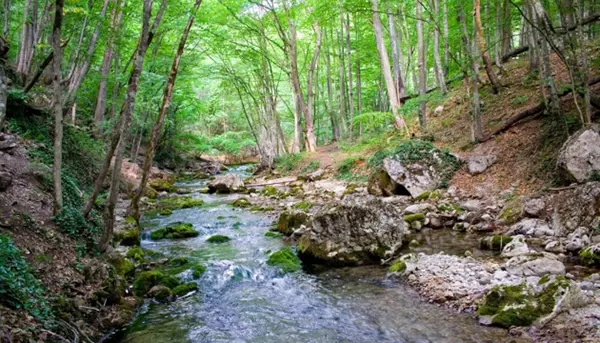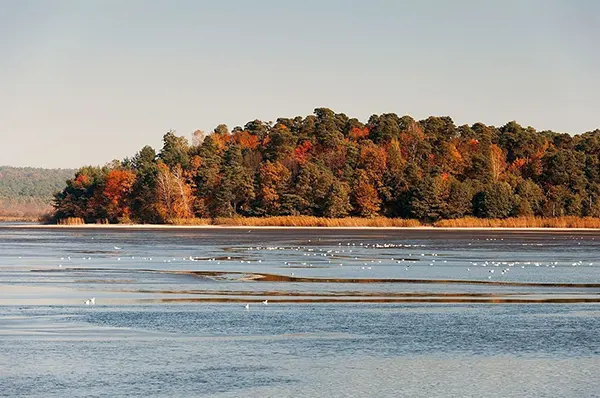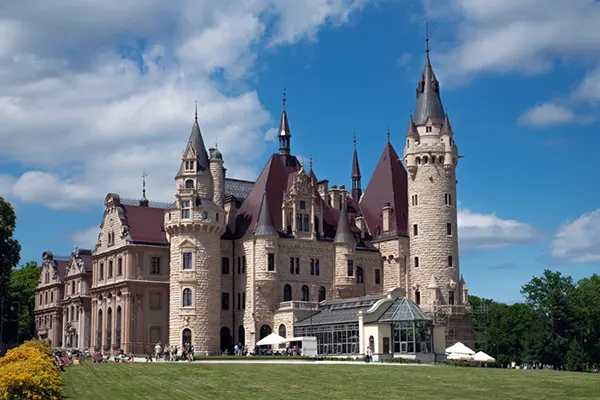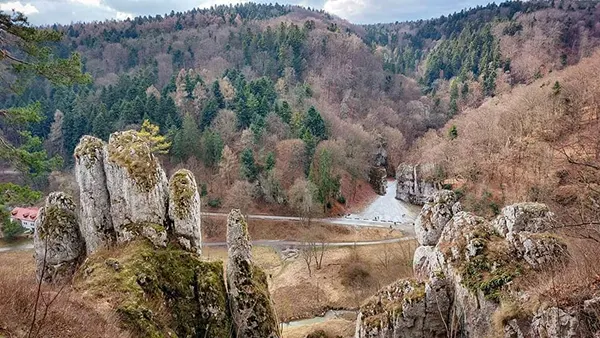
Roztocze — the Green Pearl of Eastern Poland
Roztocze, a scenic region stretching across the Lublin Voivodeship in eastern Poland, has become a quiet favourite among travellers seeking calm landscapes, gentle hills and nature protected for generations. It remains less known internationally, yet it offers a combination of river valleys, forest paths and karst formations that stand apart from Poland’s crowded tourist routes. For those who look for authentic rural scenery, clear air and routes designed for slow travel, Roztocze represents one of the country’s most rewarding areas to explore.
Walking and Cycling Routes Across Roztocze
The character of Roztocze is shaped by its mild uplands, which create long viewpoints and accessible paths suitable for both relaxed walking and multi-day cycling routes. Local trails connect villages, woodland clearings and quiet riverbanks, making it possible to follow natural lines of the landscape rather than rushed, urbanised routes. The region’s rural planning has preserved many of these corridors for outdoor recreation, helping visitors discover the terrain gradually and safely.
Among the best-known paths is the Central Roztocze Route, which links several protected areas and introduces walkers to mixed forests, lime-rich springs and distinctive dry valleys. Cyclists often choose the Green Velo Trail as their main axis through the region, as it is consistently maintained and designed for long stretches without heavy traffic. In many areas, the route is separated from local roads, supporting a more relaxed rhythm of travel and better contact with natural surroundings.
Even short walks reward visitors with varied scenery thanks to the area’s geology. Gentle slopes, small waterfalls, beaver dams and limestone outcrops appear in close proximity, creating conditions where routes remain interesting without requiring advanced fitness. Waymarking has improved in recent years, allowing families and less experienced travellers to follow safe-distance circuits with clear signage.
How Local Terrain Shapes the Outdoor Experience
The Roztocze uplands are defined by their porous limestone base, which enables the formation of underground channels and natural springs. This geology affects not only the presence of karst lakes and rivers but also the type of vegetation found along routes. Travellers frequently encounter shady beech stands, oak clusters and meadows where ground moisture changes within short distances, creating striking contrasts in plant cover.
The region’s elevation — generally between 250 and 400 metres — makes it accessible for a wide range of visitors. Hills are long rather than steep, favouring gradual ascents and wide ridges where the landscape opens into slow, panoramic views. These characteristics explain why Roztocze is promoted domestically as a model area for soft outdoor tourism, reducing pressure on more fragile mountain environments elsewhere in Poland.
Seasonality plays a significant role in shaping the user experience. Spring brings fast-flowing streams and bright forest undergrowth, while summer emphasises meadows and shaded paths. By autumn, the mix of deciduous species produces dense colour variations, attracting photographers and nature observers. Winter walking remains possible on low-lying routes, as snow cover is often uniform and paths are rarely exposed to high winds.
Roztoczański National Park
Roztoczański National Park, situated near Zwierzyniec, protects some of the region’s most characteristic ecosystems. Established to safeguard forest complexes and limestone formations, it has grown into one of Poland’s leading examples of balanced conservation. The park preserves wetlands, old-growth stands of fir and beech, and habitats shaped by underground water circulation, ensuring that species adapted to these conditions remain stable.
Visitors can follow designated educational paths that explain the park’s flora, fauna and hydrology without disturbing sensitive areas. The Echo Ponds, formed by natural processes and later restored, are particularly valued for birdwatching and quiet observation. Wildlife is present throughout the park, including roe deer, foxes and, in certain zones, European bison introduced through breeding programmes coordinated with other Polish reserves.
The park management collaborates with local municipalities to maintain routes designed for minimal environmental impact. Boardwalks protect moist ground, while designated viewing points help regulate visitor flow. Since 2022, updated infrastructure has supported barrier-free access in selected locations, allowing wider groups of visitors — including those with mobility needs — to experience the area responsibly.
Natural Values Preserved Through Long-Term Protection
The ecological importance of Roztoczański National Park lies in its mosaic of forest and water-based habitats. Many species are linked to groundwater-fed systems typical of Roztocze, including amphibians that breed in shallow, stable pools and insects that depend on high-quality stream edges. This combination supports a diverse food web and allows researchers to monitor long-term environmental trends.
Forest preservation policies have maintained many stands in a semi-natural state. Old trees support fungi, mosses and birds that rely on decaying wood, which is now recognised as essential for overall forest health. Efforts to balance visitor presence with habitat needs have resulted in strict zoning measures, ensuring that public routes avoid core breeding areas or zones with unstable terrain.
The park also plays an educational role, helping visitors understand why such landscapes require patient management. Information points describe geological processes, water retention, the importance of tree age distribution and the role of species corridors linking forest patches. This approach encourages informed tourism and raises awareness of how individual behaviour influences long-term conservation.

Eco-Tourism and Peaceful Travel in the Region
Roztocze has gradually developed a regional model of eco-tourism that strengthens local communities while protecting environmental integrity. Accommodation tends to be small-scale and family-operated, supporting a pattern of responsible travel rather than mass movement. Farms, rural homes and craft-based enterprises offer visitors insights into everyday life and traditional practices of the Lublin region.
Transport connections have improved, allowing visitors to reach towns such as Zwierzyniec and Krasnobród using regional buses or rail links. Once in the area, slow travel becomes the guiding principle: walking routes, gravel cycling paths and access to forests encourage a quieter pace that benefits both the environment and visitor wellbeing. This approach aligns with Poland’s wider strategy of promoting less congested destinations that remain resilient to seasonal fluctuations.
For those seeking calm, Roztocze offers conditions that support reflection, reading and outdoor rest without artificial noise. Many travellers choose early morning walks along river valleys, where mist forms above cool water surfaces, or evening routes through forest edges rich in bird activity. Local advice consistently emphasises respect for nature — staying on marked paths, carrying waste back to towns and limiting disturbance to wildlife during breeding seasons.
Practical Tips for a Comfortable Stay
Visitors benefit from planning daily routes according to weather, as the region’s microclimates can shift quickly due to woodland cover and varied terrain. Light waterproof clothing is advisable in all seasons, as sudden rain is common in upland zones. Maps provided by local tourist centres outline distances and difficulty levels, helping travellers choose routes suited to their abilities.
Local shops and guesthouses often supply regional foods ideal for longer excursions. Bread, smoked cheese and fruit-based preserves are widely available and travel well in warm conditions. Water sources are generally safe, but carrying sufficient bottled water is recommended for summer outings, especially on longer cycling stages.
Many cultural sites — wooden chapels, roadside shrines and small museums — lie near main paths, allowing visitors to combine outdoor activity with local heritage. Respectful behaviour and awareness of private property boundaries help maintain positive relations between visitors and residents, supporting a sustainable model of tourism that benefits the entire region.
Popular articles
-
 Moszna Castle: A Fairytale Landmark of Lower Silesia
Moszna Castle: A Fairytale Landmark of Lower SilesiaMoszna Castle stands as one of the most recognisable historical …
-
 Roztocze — the Green Pearl of Eastern Poland
Roztocze — the Green Pearl of Eastern PolandRoztocze, a scenic region stretching across the Lublin Voivodeship in …
-
 Kraków Valleys — Picturesque Gorges, Rocks and Walking Trails near Kraków
Kraków Valleys — Picturesque Gorges, Rocks and Walking Trails near KrakówThe Kraków Valleys, known in Polish as Dolinki Krakowskie, are …
